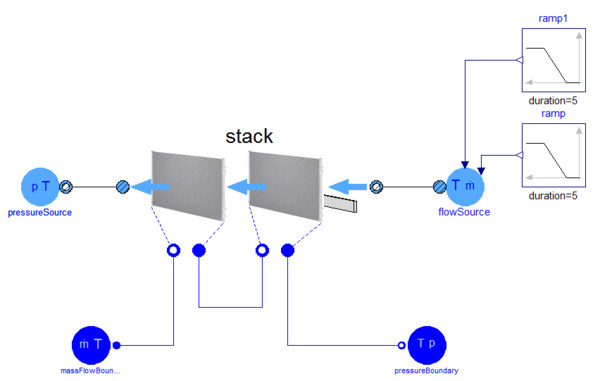Heat Exchanger Library provides an environment for heat-exchanger design and analysis with interfaces for convenient system model integration. It contains a large number of geometry-based heat exchangers with a focus on compact designs, such as plate and micro-channel types. Both two-phase media such as refrigerants, and single-phase fluids like incompressible liquids, air or pressurized gases are supported.
Heat-transfer and pressure drop are determined by state-of-the-art correlations from the open literature or user-defined operating point input with an interface for calibration with experimental data. The openness of the library allows the user to combine own models based on in-house knowledge with available sub-components and templates from the library.
One key aspect of Heat Exchanger Library is the convenient setup of heat exchangers in series, in order to investigate the impact of their respective positions on performance. Temperature and flow velocity distributions can be monitored inside the heat exchangers or supplied as 2D boundary conditions, e.g. from CFD data. One common example is the heat exchanger stack in the air flow located behind the front grille opening of a vehicle.
Heat Exchanger Library integrates seamlessly with Vapor Cycle Library and Liquid Cooling Library to model complete thermal management architectures including energy transport, cooling, heating, refrigeration and heat generation.

Diagram of two stacked heat exchangers with partial overlap and an obstacle, which for instance can be used to study the air intake of cars or trucks.
APPLICATIONS
Heat Exchanger Stacks
Heat exchanger stacks are a key coupling point between fluid circuits. The Heat Exchanger Library provides detailed, geometry-based models that can be stacked using a stream-tube approach for the airflow. This preserves non-uniform conditions for each heat exchanger in the stack.
Heat exchanger models in the library accept both uniform and non-uniform airflow inputs. This formulation is efficient enough to support drive-cycle work for a reasonable number of stream tubes.
Check out the technical paper Integrated Vehicle Thermal Management in Modelica, where results from heat exchanger stack simulations support cooling pack concept assessment.

Streamtube approach and sample stack from the Heat Exchanger Library
Heat exchanger dimensioning and design
The Heat Exchanger Library, including a wide variety of heat exchanger models, is our reference tool for heat exchangers design. Testbenches are readily available, reducing both modelling time and simulation setup time.
Active grill shutters
The Heat Exchanger Library is the right tool for the development of control strategies for active grill shutters.
Heat exchangers are often the physical boundary between a fluid circuit and the ambient air. This implies that their performance affects the underlying system efficiency but also has consequences on the air side. This trade-off is most apparent in the automotive industry where a reduced air intake, by closing grill shutters, reduces the vehicle’s drag coefficient. The Heat Exchanger Library permits the study of this interaction, since the heat exchangers can be coupled to CFD results on one side and a system model on the other.
Intercooler design
Intercoolers are a key element to improve the volumetric efficiency of combustion engines. The Heat Exchanger Library contains a wide set of application-specific models, which can be easily parameterized to represent your air-to liquid intercoolers or charge air coolers.
The Heat Exchanger Library is used in all applications that require detailed heat exchanger models.
Resources
Modelon Libraries
Related News & Blog
Ready to use Modelon's libraries for powerful system simulation?
Get in touch with us today to see how Modelon’s libraries handle complex modeling and return accurate results.


